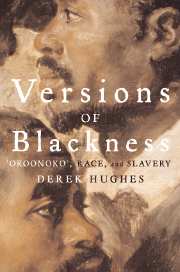Book contents
- Frontmatter
- Contents
- Introduction
- A Note on the Texts
- Chronology
- PART ONE THE MAJOR TEXTS
- PART TWO CONTEXTS: EUROPE, AMERICA, AND AFRICA
- A Short Account of the Destruction of the Indies
- Democrates Secundus
- “Of the Cannibals” and “Of Coaches”
- On Spreading the Gospel Among the Savages
- The English-American his Travail by Sea and Land
- A True and Exact History of the Island of Barbados
- The History of Sir Francis Drake
- Voyage de la France Equinoxiale en l'Isle de Cayenne
- An Exact Relation of the Most Execrable Attempts of John Allin
- The History of the Caribby-Islands
- Histoire Generale des Antilles Habitées par les François
- An Impartial Description of Surinam
- Great Newes from the Barbadoes
- The Negro's and Indians Advocate
- Friendly Advice to the Gentlemen Planters of the East and West Indies
- DISCUSSIONS OF COLONIALISM
- Bibliography
- Index
The English-American his Travail by Sea and Land
Published online by Cambridge University Press: 05 June 2012
- Frontmatter
- Contents
- Introduction
- A Note on the Texts
- Chronology
- PART ONE THE MAJOR TEXTS
- PART TWO CONTEXTS: EUROPE, AMERICA, AND AFRICA
- A Short Account of the Destruction of the Indies
- Democrates Secundus
- “Of the Cannibals” and “Of Coaches”
- On Spreading the Gospel Among the Savages
- The English-American his Travail by Sea and Land
- A True and Exact History of the Island of Barbados
- The History of Sir Francis Drake
- Voyage de la France Equinoxiale en l'Isle de Cayenne
- An Exact Relation of the Most Execrable Attempts of John Allin
- The History of the Caribby-Islands
- Histoire Generale des Antilles Habitées par les François
- An Impartial Description of Surinam
- Great Newes from the Barbadoes
- The Negro's and Indians Advocate
- Friendly Advice to the Gentlemen Planters of the East and West Indies
- DISCUSSIONS OF COLONIALISM
- Bibliography
- Index
Summary
Thomas gage (d. 1656) was a member of a prominent Catholic family. Against the wishes of his father, who wanted him to become a Jesuit, Thomas joined the Dominican order in Spain and set off for missionary work in the Philippines. Pausing en route in Mexico, he became disillusioned with the corruption of the Catholic church and made a cliff-hanging escape back to England. He was convinced that the Native Americans would welcome the English as liberators from Spanish oppression and was instrumental in encouraging Cromwell's largely unsuccessful Caribbean campaign of 1655. He served as chaplain on the expedition and died in Jamaica. Gage's work draws parallels between the cruel idolatry of the Aztecs and the practices of the Catholic church and interestingly shows how corrupt priests mingled Christianity and pagan superstition in order to extract money from the Native Americans. In a slight anticipation of Oroonoko, he describes the bravery of slaves in fighting with wild bulls and wrestling with alligators in rivers (129).
The charitable motives of Gage's dedication are somewhat contradicted by the ensuing commendatory poem by Thomas Chaloner (one of the signatories of Charles I's death sentence). It compares the colonial enterprise with Richard I's Crusade, and boasts
Now shall the tawnie Indians quake for fear,
Their direfull march to beat when they doe hear.
(sig. [A5])Gage, however, drew a more idealistic vindication of colonialism from the Quaker William Loddington (1626–1711), who stressed the missionary aspect of English expansion.
- Type
- Chapter
- Information
- Versions of BlacknessKey Texts on Slavery from the Seventeenth Century, pp. 295 - 299Publisher: Cambridge University PressPrint publication year: 2007



